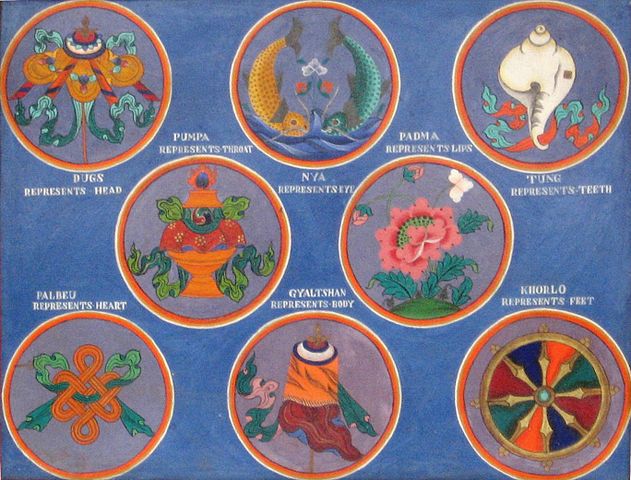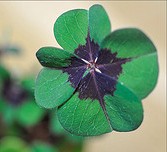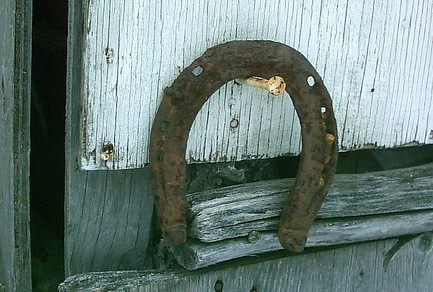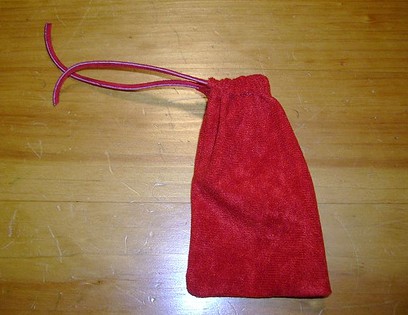Last time, we explored how our brain’s behavior can affect our gaming behavior, but that’s hardly the only factor. We all know that luck plays a role too. It always seems like some of us are luckier than others, but can that ever change? For as long as there have been superstitions (so, forever) and luck-based games (so, almost forever), people have cursed their fate and tried to manipulate their odds. Gamers don’t often resort to wards or spells, though I hear the Dice Witch does pretty good business. We tend to favor our lucky charms, though. Be it a cat’s eye gem or a stone with a ring around it, there are almost as many types of luck charms as there are ways to win a game. Below, I’ve looked at some of the most common.
Ashtamangala (Asia)
 The Ashtamangala is a traditional set of eight symbols that appear primarily in Indian art and religion. They’re associated with three major belief systems: Buddhism, Hinduism, and Jainism (a minority religion in India whose main spiritual focus is peace and nonviolence).
The Ashtamangala is a traditional set of eight symbols that appear primarily in Indian art and religion. They’re associated with three major belief systems: Buddhism, Hinduism, and Jainism (a minority religion in India whose main spiritual focus is peace and nonviolence).
The exact symbols differs depending on which religion is producing the symbols. The Buddhist ashtamangala, for instance, features an endless knot and a conch shell, while the Hindu set features a bull and a trumpet. Even within a particular religion, the symbols used can vary regionally or by sect. The Jainists, who are divided into two main groups, have two different ashtamangalas.
Still, regardless of the symbols used, the overall grouping is said to represent fortune and is used to teach virtue to followers.
Four Leaf Clover (Europe)
 It should come as no surprise that our first lucky charm originates from a culture known for their good fortune. The four leaf clover is one of the most recognizable symbols of good luck in modern western society. It’s traditionally associated with Ireland, and it’s said that there are more four-leaf clovers there than anywhere else (hence the “Luck of the Irish”).
It should come as no surprise that our first lucky charm originates from a culture known for their good fortune. The four leaf clover is one of the most recognizable symbols of good luck in modern western society. It’s traditionally associated with Ireland, and it’s said that there are more four-leaf clovers there than anywhere else (hence the “Luck of the Irish”).
Each leaf of the clover is symbolic. The first represents faith, the second hope, the third love, and the fourth luck.
Generally, your odds of finding a four-leaf clover is 1 in 10,000. To put that in perspective, your odds of being killed by lightning while looking for the clover is 1 in 79,746. Your odds of being deaded in a car accident on the way to look the clover patch is 1 in 84. Your odds of offing yourself due to your lack of luck is 1 in 119.*
Interestingly, four-leaf clovers are not the ultimate powerup. Five-leaf clovers do exist, and they’re said to be even luckier than their four-leaf sisters. Of course, you chance of finding one is probably 1 in 1,000,000.
Rabbit’s Foot (Basically Everywhere)
 This one is a bit of a mystery. No one could accurately say where the tradition of taking the foot of a speedy animal began. Some sources cite ancient African lore, while others put its origins in Europe, Asia, or even the early Americas. Regardless, each culture believed that the animal’s swiftness would be imparted onto the holder of the corpse-part, allowing the person to flee quickly from danger and, presumably, ill luck.
This one is a bit of a mystery. No one could accurately say where the tradition of taking the foot of a speedy animal began. Some sources cite ancient African lore, while others put its origins in Europe, Asia, or even the early Americas. Regardless, each culture believed that the animal’s swiftness would be imparted onto the holder of the corpse-part, allowing the person to flee quickly from danger and, presumably, ill luck.
What’s interesting here is that the more unlucky the rabbit, the more lucky the foot. Traditionally, rabbit foot charms are made from the left hind paw, which is considered . . . well, bad, because it’s the opposite of the right and the front (which are both good). Rabbits that were killed in graveyards, particularly on top of the graves of evil people, were even luckier. There’s a rumor that President Cleveland had a rabbit’s foot from an animal killed over the grave of Jesse James, though whether you think Grover Cleveland was actually a lucky man is a bit up for debate (after all, he’s the only person to have the dubious honor of being president twice).
Horseshoe (Europe)
 Iron horseshoes, when hung above doorways, are said to bring good luck onto those who pass beneath them. There is some controversy within the world of horseshoe superstition regarding the proper hanging of the shoe. Heel side up, or heel side down? It depends on whether you believe that the shoe captures bad luck and holds it (heel side up) or captures good luck and drops it down onto anyone who walks underneath (heel side down).
Iron horseshoes, when hung above doorways, are said to bring good luck onto those who pass beneath them. There is some controversy within the world of horseshoe superstition regarding the proper hanging of the shoe. Heel side up, or heel side down? It depends on whether you believe that the shoe captures bad luck and holds it (heel side up) or captures good luck and drops it down onto anyone who walks underneath (heel side down).
Yeah, it’s a thing.
Either way, it’s best to make sure that your horseshoe is securely fastened to the wall, lest you end up in some Wile E. Coyote situation.
The story behind this is part of Christian mythology. It’s said that the devil was passing through the countryside one day when he happened upon (as devils are wont to do) a blacksmith. He saw the horseshoes that the blacksmith was making and thought they would look mighty fine on his own fiery hooves. The blacksmith made him some shoes and nailed them directly into the devil’s hooves. The devil paid him, but the blacksmith wasn’t an idiot and threw the money directly into his fire (I am admittedly unsure how this fact impacts the rest of the story, but there you have it). The devil enjoyed the shoes for awhile, but soon they began to hurt him. They caused so much pain that he eventually tore them off his feet and, to this day, will not go near a horseshoe.
Mojo Bag (North America)
 If one lucky charm is good, and two are better, then you might as well throw as many as you can together, right? Enter the mojo bag. Born from African tribal ceremonies and modern voodoo, the mojo bag carries a slew of lucky objects (and the occasional spell or two). Many of these bags are made from red flannel, but other makers use different colors depending on the desired effect. They are also specially tailored to the individual receiving the charm – what’s in my mojo bag will be different than what’s in yours – as no one’s luck needs are entirely identical.
If one lucky charm is good, and two are better, then you might as well throw as many as you can together, right? Enter the mojo bag. Born from African tribal ceremonies and modern voodoo, the mojo bag carries a slew of lucky objects (and the occasional spell or two). Many of these bags are made from red flannel, but other makers use different colors depending on the desired effect. They are also specially tailored to the individual receiving the charm – what’s in my mojo bag will be different than what’s in yours – as no one’s luck needs are entirely identical.
It’s said that mojo bags need to be carried on the person in order to work, and they’re often kept concealed in pockets or around the neck.
Of course, those aren’t the only lucky symbols. Pretty much anything not inherently evil has been ascribed fortune-bringing properties at one point or another. Bamboo, ladybugs, rain on your wedding day, dreamcatchers, jade, certain fish, even more fish, the number seven, the number eight . . . the list could go on for awhile, so I’ll just stop there. Personally, I take the profusion of lucky this-and-thats to be a good thing. If anything can be lucky, I probably already have a few charms lying around the house, which means I don’t have to slaughter a rabbit over the grave of Ted Bundy. Frees up my weekend, at the very least.
* Statistics for deaths by lightning strike, car accident, and suicide found here.
![]()
Erin Ryan is a regular contributor to the site. Do you have specific lucky charms? Feel free to share them with us over on our forums!
Photo Credits: Ashtamangala by Wiki Commons; Clover by Romtomtom; Rabbit meme by maugre; Horseshoe by Jacob Earl; Mojo Bag by Jeff Moser.
